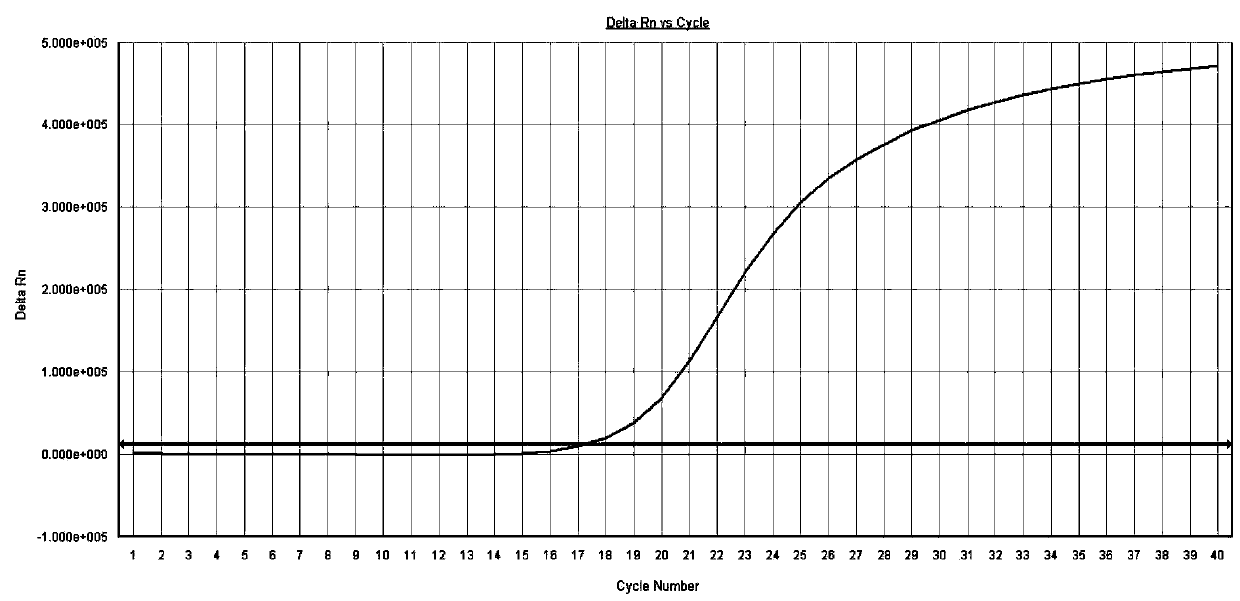ROS1 fusion gene ARMS fluorescent quantitative PCR typing detection kit
A detection kit and gene fusion technology, which is applied in the field of molecular biology detection, can solve the problems such as the inability to obtain amplification products, and achieve the effects of simplified experiments, shortened lengths, and high resolution
- Summary
- Abstract
- Description
- Claims
- Application Information
AI Technical Summary
Problems solved by technology
Method used
Image
Examples
Embodiment 1
[0065] Example 1: Design and screening of primers and probes for RT-ARMS-qPCR detection of ROS1 fusion gene variants
[0066] 1. ARMS primer design
[0067] When designing ARMS primers in the present invention, Taq enzyme lacks 3'-5' exonuclease activity. When the 3' end of the primer cannot be completely matched with the template, PCR amplification cannot be performed. The 3' end of the primer is designed to only match the mutant template, but not the normal template. The primer can only amplify the mutant template, but not the normal template, so as to achieve the purpose of typing.
[0068] On the basis of conventional ARMS primers, the present invention introduces a mismatched base at the 3rd base and the 7th base from the 3' end of the primer respectively, so as to enhance the specificity of the primer and suppress non-specific amplification.
[0069] The position of the mutation site is crucial to the specificity of the primer, and some mutation sites cannot prevent the...
Embodiment 2
[0100] Example 2: Specific investigation of primers and probes for RT-ARMS-qPCR detection of ROS1 fusion gene variants
[0101] Using DNA plasmids containing ROS1 fusion gene Variant1, Variant2, Variant3, Variant4, Variant5, Variant6, Variant7, Variant8, Variant9 and Variant10 genomic fragments as sample templates, the primers and probe combinations screened in Example 1 were used for RT-ARMS -qPCR detection.
[0102] The detection reaction system is: 1 μL of primer and probe mixture (concentration: 5uM), 2 μL of sample template DNA (100-300 ng / μL), 15 μL of 2*Taqmanuniversal PCR MasterMix (purchased from Applied Biotech, USA), ddH 2 07 μL.
[0103] PCR reaction conditions: pre-denaturation at 95°C for 30 seconds; 20 cycles of amplification at 95°C for 15 seconds and 20 seconds at 62°C; 40 cycles of amplification at 95°C for 15 seconds and 60°C for 34 seconds.
[0104] The result is: the primer and probe combination (comprising the forward primer shown in SEQIDNO.1 and the r...
Embodiment 3
[0115] Example 3: ROS1 fusion gene ARMS fluorescent quantitative PCR typing detection kit
[0116] The ROS1 fusion gene ARMS fluorescent quantitative PCR typing detection kit of the present invention includes the fluorescent quantitative reaction premix (PCRMasterMix), fluorescent quantitative reaction solution A, fluorescent quantitative reaction solution B and fluorescent quantitative reaction solution C of independent packaging respectively; And positive control Sample A, positive control sample B and positive control sample C are assembled together in an outer packaging box.
[0117] Wherein, the fluorescent quantitative reaction solution A includes three forward primers, a common reverse primer and a fluorescent probe for detecting ROS1 fusion gene variants Variant1, Variant9 and Variant10 screened in Example 1;
[0118] Fluorescent quantitative reaction solution B, including four forward primers, a common reverse primer and a fluorescent probe for detecting ROS1 fusion g...
PUM
 Login to View More
Login to View More Abstract
Description
Claims
Application Information
 Login to View More
Login to View More - Generate Ideas
- Intellectual Property
- Life Sciences
- Materials
- Tech Scout
- Unparalleled Data Quality
- Higher Quality Content
- 60% Fewer Hallucinations
Browse by: Latest US Patents, China's latest patents, Technical Efficacy Thesaurus, Application Domain, Technology Topic, Popular Technical Reports.
© 2025 PatSnap. All rights reserved.Legal|Privacy policy|Modern Slavery Act Transparency Statement|Sitemap|About US| Contact US: help@patsnap.com



